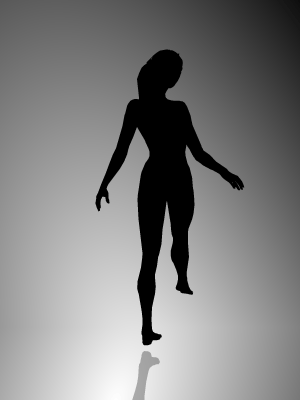Oct 11 2007
Left Brain – Right brain and the Spinning Girl
Take a look at the spinning girl below. Do you see it spinning clockwise or counter-clockwise? I see it spinning counter-clockwise, and I had a hard time getting it to switch direction. Give it a try. 
These kinds of optical illusions are always fun. What they reveal is how our brain processes visual information in order to create a visual model of the world. The visual system evolved to make certain assumptions that are almost always right (like, if something is smaller is it likely farther away). But these assumptions can be exploited to created a false visual construction, or an optical illusion.
The spinning girl is a form of the more general spinning silhouette illusion. The image is not objectively “spinning” in one direction or the other. It is a two-dimensional image that is simply shifting back and forth. But our brains did not evolve to interpret two-dimensional representations of the world but the actual three-dimensional world. So our visual processing assumes we are looking at a 3-D image and is uses clues to interpret it as such. Or, without adequate clues it may just arbitrarily decide a best fit – spinning clockwise or counterclockwise. And once this fit is chosen, the illusion is complete – we see a 3-D spinning image.
By looking around the image, focusing on the shadow or some other part, you may force your visual system to reconstruct the image and it may choose the opposite direction, and suddenly the image will spin in the opposite direction.
This news article, like many others, ignores the true source of this optical illusion and instead claims it is a quick test to see if you use more of your right brain or left brain. This is utter nonsense, but the “right-brain/left brain” thing is in the public consciousness and won’t be going away anytime soon. Sure, we have two hemispheres that operate fine independently and have different abilities, but they are massively interconnected and work together as a seamless whole (providing you have never had surgery to cut your corpus callosum).
We also do have hemispheric dominance, but that determines mostly your handedness and the probability of language being on the right or the left. There is also often asymmetry for memory, with some being right or left hemisphere dominant. But none of this means that your personality or abilities are more right brain or left brain. That much is nonsense.
Further, how your visual cortex constructs this optical illusion says nothing about your hemispheric dominance, and is absolutely not a quick personality profile.
Addendum:
This was sent to me by a reader. It is another alleged left brain/right brain test. Find the man in the coffee beans. This is being passed around as an eRumor with the following claims:

Doctors have concluded that, if you find the man in 3 seconds, then the Right half of your brain is better developed than most people.
If you find the man between 3 seconds and one minute, then your right Half of the brain is developed normally.
If you find the man between one minute and 3 minutes, then the right Half of your brain is functioning slowly and you need to Eat more protein.
If you have not found the man after 3 minutes, the right half of your Brain is a mess, and the only advice is to look for more of these types of exercises to make that part of the brain stronger. The man is really there. Keep looking!
The text is almost complete nonsense. The idea of using tests of visual-spacial ability is legitimate and is part of certain standardized tests, but not this picture. Tasks such as constructing complex figures, drawing a clock, bisecting lines, etc. are used. Such tasks are designed to, as much as possible, isolate the ability – and therefore the corresponding brain structure – of interest.
This task would not be a good candidate for visual-spacial ability because it is ambiguous. One might think that they are looking for the face or figure of a man emerging from the pattern of the coffee beans – a phenomenon called pareidolia. So this task may be difficult for someone, not because they lack visual-spacial ability, but because they interpreted the instructions in such a way as to apply the wrong strategy.
Further – no one simple test can ever give you a reliable measure of ability. You need to do a battery of tests and look for patterns of strengths and weaknesses. Someone could get lucky on one test, or get stuck on a single test, and therefore it says very little about their overall ability. Also, any test, in order to be usable, must be validated. That means the test must be applied to known quantities to see if it is actually measuring something, and if it is reliable. Will the same person score similarly at different times, for example? The scoring must also be calibrated – what does it really mean if it takes you > 1 minute to find the man?
The idea of eating protein to help your right brain comes out of left field and is just pure silliness.
Visual-spacial skills do localize to the right parietal lobe in most people, but some people are the opposite. But having good visual-spacial skills does not mean that one’s entire right hemisphere is dominant or functions better. Each ability, whether it localizes to the right or left hemisphere, can vary independently.
While it is fun to look for hidden pictures, this amounts to little more than a game and is not a valid test for anything. To be clear, this kind of task may be a useful part of a battery of tests designed to assess aspects of cognitive function, but would only be useful if they were designed properly and validated, which this test has not.






